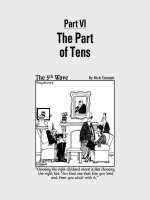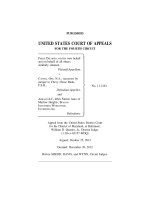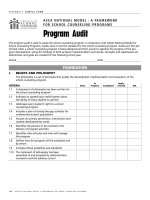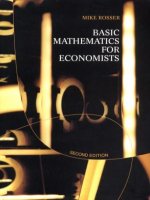Basic Mathematics for Economists - Rosser - Answers docx
Bạn đang xem bản rút gọn của tài liệu. Xem và tải ngay bản đầy đủ của tài liệu tại đây (106.14 KB, 13 trang )
Answers
Chapter 2
2.1 1. 3,555 2. 865 3. 92,920 4. 23
2.2 1. 919 2. 225 3. 164 4. 627
5. 440 6. 101
2.3 1. 840 2. 17 3. 172 4. 122
5. £13,800 6. 598 7. £176
2.4 1.
73
168
2.
101
252
3. 4
4
5
4.
19
30
5. 2
13
21
6. 4
37
60
7. 14
1
12
8. 3
12
13
9. 18
39
40
10. 1
1
2
2.5 1. (a)
1
3
(b)
5
7
(c) 1
2
5
(d) 3 (e) 11
2. 1 3. (a) 1 (b) 5 4. 15, 4
1
3
, 2
1
5
, 1
2
7
,
7
9
,
5
11
,
3
13
,
1
15
2.6 1. 36.914 2. 751.4 3. 435.1096 4. 36,082
5. 0.09675 6. 610 7. 140
8. (a) 0.1 (b) 0.001 (c) 0.000001
9. (a) 0.452 (b) 2.431 (c) 0.075 (d) 0.002
2.7 1. −22.−24 3. −33 4. 0.45 5. 0.35
6. −117 7. −330 8. 3600
9.
−157
140
10.
17
16
2.8 1. 0.25 2. 123 3. 6 4. 64
5. 11.641754 6. 531,441 7. 0.0015328 8. 36
9. −618.47021 10. 25.000655
© 1993, 2003 Mike Rosser
2.9 1. ±25 2. 2 3. 0.2 4. 7 5. 2.4494897
6. 96 7. 10
8. 5.2780316 9. 0.03423 10. 87.977857
2.10 1. 270,818.98 2. 220.9478 3. 2.8563 × 10
9
4. 1.5728 × 10
8
5. 1.2683 6. 16,552,877 7. 93.696376 8. 4.38228
9. 5.1331868
Chapter 3
3.1 1. (a) 0.01x (b) 0.5x (c) 0.5x 2. 0.01rx + 0.5wx + 0.5mx
3. (a)
x
12
(b)
xp
12
4. (a) 0.1x kg (b) 0.3x kg (c) x(0.1m +0.3p)
5. 0.5w + 0.25 6. Own example 7. 10.5x + 6y 8. 3q − 6000
3.2 1. 456 2. 77.312 3. r + z, 9% 4. Own example
5. 1.094 6. £465.58 7. £2,100 8. (a) 99 + 0.78M (b) £2,166
3.3 1. 30x + 42.24x − 18y + 7xy − 12 3. 6x +5y −650
4. 9H − 120
3.4 1. 6x
2
− 24x 2. x
2
+ 4x +93.2x
2
+ 6x + xy + 3y
4. 42x
2
− 16y
2
− 34xy + 6y 5. 33x +2y − 20y
2
+ 62xy − 21
6. 120 +2x + 54y + 40z − x
2
+ 6y
2
+ xy + 4xz + 8yz
7. 200q − 2q
2
8. 13x +11y 9. 8x
2
+ 60x +76
10. 4,000 +150x
3.5 1. (x +4)
2
2. (x −3y)
2
3. Does not factorize
4. Does not factorize 5. Own example
3.6 1. 3x +7 −20x
−1
2. x +93.4y + x +12 4. 200x
−1
+ 21
5. 179x 6. 2(x + 3) + 4 − x − 3 − x + 2 = 9 7. Own example
3.7 1. 4 2.
1
11
3.7 4.14 5.82 6.20p 7.33%
8. 40p 9. £3,062.50 10. 4 m 11. 26
3.8 1.
1
n
n
i=1
H
i
, 173.7 cm 2. 35 3. 60
4.
n
i=1
6,000(0.9)
i−1
,16,260 tonnes 5. (a)
1
n
n
i=1
R
i
, £4,425
(b)
1
3
n−1
n−3
R
i
, £4,933 6. 13.25%, 8.2
3.9 1. (a) ≤ (b) < (c) ≥ (d) > 2. (a) > (b) ≥ (c) > (d) >
3. (a) Q
1
<Q
2
(b) Q
1
= Q
2
(c) Q
1
>Q
2
4. P
2
>P
1
© 1993, 2003 Mike Rosser
Chapter 4
4.1 1. (a) Quantity demanded depends on the price of tea, average exp., etc.
(b) Q
t
dependent, all others independent.
(c) Q
t
= 99 − 6P
t
− 0.5Y
t
+ 0.8A +1.2N + 1.4Pc
(suggested number assumes tea is an inferior good)
2. (a) 202 (b) 7 (c) 6, x ≥ 0 3. Yes; no
4.2 1.
◦
F = 32 + 1.8
◦
C2.P = 2,400 − 2Q
3. It is not monotonic, e.g. TR = 200 when q = 5or10
4. T = (0.0625X − 25)
2
; no 5. Own example
4.3 (Answers to 1 to 5 give intercepts on axes)
1. x =−12,y = 62.x = 3
1
3
,y =−40 3. P = 60,Q = 300
4. P = 150,Q= 750 5. K = 24,L= 40 6. Goes through origin only
7. Goes through (Q = 0, TC = 200) and (Q = 10, TC = 250)
8. Horizontal line at TFC = 75 9. Own example
10. (a) and (d); both slope upwards and have positive intercepts on P axis
4.4 1. Q = 90 −5P ; 50; Q ≥ 0,P ≥ 02.C = 30 + 0.75Y
3. By £20 to £100 4. P = 12 − 0.015Q 5. £6,440
4.5 1. 3.75, 0.75, 0.375, −0.75 2. P = 12,Q = 40;£4.50; 10 3. (a) 2/3 (b) 3
4. (c) (i) (a) (ii) (b) 5. (a), (d) 6. APC = 400Y
−1
+ 0.5 > 0.5 = MPC
7. (a) 0.263 (b) 0.714 (c)1.667 8. Own example
4.6 1. −1.5 (a) becomes −1 (b) becomes −1 (c) no change (d) no change
2. K = 100,L= 160,P
K
= £8,P
L
= £5
3. Cost £520 > budget; P
L
reduced by £10 to £30
4. (a) −10 (b) −1 (c) −0.1 (d) −0.025 (e) 0 5. No change
6. Height £120, base 12, slope −10 =−(wage) 7. Own example
4.7 1. Sketch graphs 2. Sketch graphs 3. Steeper
4. Like y = x
−1
;£260 5. Own example
4.8 1. Sketch graphs 2. Own example 3. π = 50x − 100 −0.4x
3
; inverted U
4. (a) 40 = 3250q
−1
(b) Original firms’ π per unit = £27.50 but new firms’ AC = £170 > price
4.9 Plot Excel graphs
4.10 1. (a) 16L
−1
(b) 0.16 (c) constant
2. (a) 57,243.34L
−15
(b) 57.243 (c) constant
3. (a) 322.54L
−1
(b) 3.2254 (c) increasing
4. (a) 3,125L
−1.25
(b) 9.882 (c) increasing
© 1993, 2003 Mike Rosser
5. (a) 23,415,916L
−1.6667
(b) 10,868.71 (c) decreasing
6. (a) 4,093.062L
−1.7714
(b) 1.173 (c) decreasing
4.11 1. MR = 33.33 − 0.00667Q for Q ≥ 500
2. MR = 76 − 0.222Q for Q ≥ 22.5
3. MR = 80 − 0.555Q for Q ≥ 562.5
4. MC = 30 +0.0714Q for Q ≥ 56
5. MC = 56 +0.1333Q for Q ≥ 30
6. MC = 3 +0.0714Q for Q ≥ 59
Chapter 5
5.1 1. q = 40,p = 62.x = 67,y = 17 (approximately) 3. No solution exists
5.2 1. q = 118,p = 256 2. (a) q = 80,p = 370 (b) q falls to 78, p rises to 376
3. Own example 4. (a) 40 (b) rises to 50 5. x = 2.102,y = 62.25
5.3 1. A = 24,B = 12 2. 200 3. x = 190,y = 60
5.4 1. x = 30,y = 60 2. A = 6,B = 36 3. x = 25,y = 20
5.5 1. x = 24,y = 14.4,z = 19.22.x = 4,y = 6,z = 4
3. A = 6,B= 22,C= 24.x = 17,y = 4,z = 8
5. A = 82.5,B = 35,C = 6,D = 9
5.6 1. q = 500,p = 275 2. K = 17.5,L = 16,R = 10
3. (a) p rises from £8 to £10 (b) p rises to £9
4. Y = £3,750 m; government deficit £150 m
5. Y = £1,625 m; balance of payments deficit £15 m
6. L = 80,w = 52
5.7 1. p = 184 + 0.2a, q = 43.2 + 0.06a,p = 216,q = 52.8
2. p = 84 + 0.2t,q = 32 − 0.4t,p = 85,q = 30
3. p = 122.4 + 0.2t,q = 13.8 − 0.1t,p = 123.4,q = 13.3
4. (a) Y = 100/(0.25 + 0.75t),Y = 250 (b) Y = 110/(0.25 +0.75t),Y = 275
5. p = (4200 + 3800v)/(9 + 5v),
q = (750 − 50v)/(9 + 5v)
p = 494.30, q = 76.94
5.8 1. q
1
= 60,q
2
= 80,p
1
= £10,p
2
= £8
2. q
1
= 40,q
2
= 50,p
1
= £6,p
2
= £4
3. p
1
= £8.75,q
1
= 60,p
2
= £6.10,q
2
= 550
© 1993, 2003 Mike Rosser
4. £81 for extra 65 units
5. £7.50 for extra 25 units
6. q
1
= 48,q
2
= 39,p
1
= £12,p
2
= £8.87
7. (a) 190 units (b) £175 for extra 75 units
5.9 1. q
1
= 180,q
2
= 200,p = £39 2. q
1
= 1,728,q
2
= 780,p = £190.70
3. q
1
= 1,510,q
2
= 1,540,q
A
= 800,q
B
= 2,250,P
A
= £500,P
B
= £625
4. q
1
= 160,q
2
= 600,q
A
= 293
1
3
,q
B
= 266
2
3
,q
C
= 200,P
A
= £95,
P
B
= £80,P
c
= £60
5. q
1
= 15.47,q
2
= 27.34,q
3
= 26.17,p = £14.20
5A.1 1. 8.4 of A, 4.64 of B (tonnes); (a) no change (b) no B, 12.16 of A
2. A = 13,B = 27 3. 12 of A, 5 of B 4. 22.5 of A, 7.5 of B
5. 6 of A, 32 of B 6. Own example
7. 13.64 of A, 21.82 of B; £7092; surplus 2.72 of R, 22.72 of mix additive
8. Produce 15 of A, 21 of B 9. 30 of A, B = 0
10. Objective function parallel to first constraint
11. 24,000 shares in X, 18,000 shares in Y, return £8,640
12. Own example
5A.2 1. C = 70 when A = 1,B = 1.5, slack in x = 30 2. A = 3,B = 0
3. Q = 2.5,R = 1.5; excesses 62.5 mg of B, 27.5 mg of C
4. 10 of A, 5 of B; space for 50 extra loads of X
5. Zero R, 15 tonnes of T; G exceeds by 45 kg
6. 100 of A, 40 of B 7. Own example
5A.3 1. 2 of A, 1 of B 2. 7.5 of X and 15 of Y (tonnes) 3. 8
4. Own example
Chapter 6
6.1 1. 2 or 3 2. 10 or 60 3. When x = 2 4. 0.5 5. 9
6.2 1. 10 or −12.5
2. £16.353. (a) 1.01 or 98.99 (b) 11.27 or 88.73 (c) no solution exists
4. Own example
6.3 1. x = 15,y = 15 or x =−3,y = 249
2. x = 1.75,y = 3.15 or x =−1.53,y = 20.97 3. 16.4
4. q
1
= 3.2,q
2
= 4.8,p
1
= £136,p
2
= £96
5. p
1
= £15,q
1
= 80,p
2
= £8.50,q
2
= 70
6.4 1. 52 2. 1069 3. 10
© 1993, 2003 Mike Rosser
Chapter 7
7.1 1. £4,630.50 2. £314.70 3. £17,623.16
4. £744.71 5. £40,441.40 6. £5,030.03
7.2 1. £43,747.41;12.68% 2. £501,159.74; 7.44% 3. (a) APR 11.35%
4. £2,083.61; 19.25% 5. £625; 5.09% 6. 19.28%
7. 0.01467% 8. £494,531.25; 4.5%
7.3 1. £6,301.69 2. £355.89 3. No, A = £9,106.27
4. £6,851.65 5. (a) £9,638.58 (b) £11,579.83 (c) £13,318.15
6. 5 7. 5.27 years 8. 12.1 years 9. 5.45 years 10. 3.42 years
11. 10.7% 12. 9.5% 13. 7.5% 14. 0.8% 15. 10.3% 16. 8.4%
17. (b) as PV = £5,269.85
7.4 1. (a) £90.75 (b) −£100.07 (c) −£474.01 (d) £622.86 (e) £1,936.87
(f) £877.33 (g) £791.25 (h) £992.16
2. B, PV = £6,569.10 3. (a) All viable (b) A best, NPV = £6,824.68
4. Yes, NPV = £7,433.56 5. Yes, NPV = £4,363.45
6. (a) Yes, NPV = £610.02 (b) no, NPV =−£522.30
7. B, NPV = £856.48
7.5 1. r
A
= 20%,r
B
= 41.6%,r
C
= 20%,r
D
= 20%;
B consistently best, but others have same IRR with different NPV ranking
2. (a) A, r
A
= 21.25%,r
B
= 20.42% (b) B, NPV
B
= £2,698.94,
NPV
A
= £2,291.34 3. IRR = 16.93%
7.6 1. (a) 2.5, 781.25, 50,857.3 (b) 3, 121.5, 14,762 (c) 1.4, 10.756, 139.6
(d) 0.8, 19.66, 267.8 (e) 0.75, 0.57, 9.06
2. 5,741 (to nearest whole unit)
3. A, £1,149.32;B,£2,980.91; C, £45,216.47
4. Yes, NPV = £3,774.71 5. £4,149.20
7.7 1. (a) k = 1.5, not convergent (b) k = 0.8, converges on 600
(c) k =−1.5, not convergent (d) k =
1
3
converges on 54
(e) converges on 961.54 (f) not convergent
2. £3,076.92 3. Yes, NPV = £50,000
4. (a) £240,000 (b) £120,000 (c) £80,000 (d) £60,000 5. £3,500
7.8 1. £152.59 2. £197.38 3. £191.46
4. £794.66 5. (a) 14.02% (b) 26.08% (c) 23.86% (d) 14.71%
6. Loan is marginally better deal (PV of payments = £6,348.33 + £1,734
deposit = £8,082.33, less than cash price by £12.67)
© 1993, 2003 Mike Rosser
7.9 1. 6.82 years 2. After 15.21 years 3. 4%
4. Yes, sum of infinite GP = 1,300 million tonnes 5. 4.85%
Chapter 8
8.1 1. 36x
2
2. 192 3. 21.6 4. 260x
4
5. Own example
8.2 1. 3x
2
+ 60 2. 250 3. −4x
−2
− 44.1
5. 0.2x
−3
+ 0.6x
−0.7
6. Own example
8.3 1. 120 −6q, 20 2. 25 3. 14,400 4. £200 5. Own example
8.4 1. 7.5 2. 12q
2
− 40q + 60
3. (a) 1.5q
2
− 6q + 25 (b) 0.5q
2
− 3q + 25 + 20q
−1
(c) q − 3 − 20q
−2
4. MC constant at 0.8 5. Own example
8.5 1. 4 2. (a) 80 (b) 158.33 (c) 40 or 120 3. 6
8.6 1. 50 −
2
3
q 2. 900 3. 24 − 1.2q
2
8.7 1. 0.8 2. Proof 3. 0.16667 4. 1
8.8 1. £77.50 2. Own example 3. Rise, maximum TY when t = £39
8.9 1. (a) 0.8 (b) 4,400 (c) 5 (d) 120 (e) Yes, both 940
Chapter 9
9.1 1. 62.5 2. 150 3. (a) 500 (b) 600 (c) 300 4. 50
9.2 1. 1,200, max. 2. 25, max. 3. 4,096, max. 4. 4, not max.
9.3 1. 6, min. 2. 14.4956. min. 3. 0, min. 4. 3, not min.
5. No stationary point exists
9.4 1. (a) MC = 2q
2
− 28q + 222, min. when q = 7, MC = 124
(b) AVC =
2
3
q
2
− 14q + 222, min. when q = 10.5, AVC = 148.5
(c) AFC = 50q
−1
, min. when q →∞=, AFC → 0
(d) TR = 200q − 2q
2
, max. when q = 50, TR = 5,000
(e) MR = 200 − 4q, no turning point, end-point max. when q = 0
(f) π =−
2
3
q
3
+ 12q
2
− 22q − 50, max. when q = 11,π = 272.67
π min. when q = 1,π =−60
2
3
2. Own example 3. (a) 16 (b) 8 (c) 12
4. No turning point but end–point min. when q = 0
5. No turning point but end–point min. when q = 0
6. Max. when x = 63.33, no minimum
© 1993, 2003 Mike Rosser
9.5 1. π max. when q = 4 (theoretical min. when q =−1.67 not realistic)
2. (a) Max. when q = 10 (b) no min. exists
3. π max. when q = 12.67, gives π =−48.8 4. 5,075 when q = 10 5. 27.6
when q = 37
9.6 1. 15 orders of 400 2. 560 3. 480 every 4.5 months 4. 140
9.7 1. (i) (a) q = 90 − 0.2t,p = 270 + 0.4t (b)&(c) q = 90,p = 270
(ii) (a) q = 250 − 1.25t,p = 125 + 0.375t (b)&(c) q = 250,p = 125
(iii) (a) q = 25 − 0.9615t,p = 160 + 0.385t (b)&(c) q = 25,p = 160
(there is no tax impact for (b) and (c) in all cases)
2. q = 100,p = 380 (no tax impact)
Chapter 10
10.1 1. (a) 3 +8x,16 + 4z (b) 42x
2
z
2
, 28x
3
z (c) 4z + 6x
−3
z
3
, 4x − 9x
−2
z
2
2. MP
L
= 4.8K
0.4
L
−0.6
, falls as L increases
3. MP
K
= 12K
−0.7
L
0.3
R
0.4
, MP
L
= 12K
0.3
L
−0.7
R
0.4
,
MP
R
= 16K
0.3
L
0.3
R
−0.6
4. MP
L
= 0.7, does not decline as L increases 5. No 6. 1.2x
−0.7
j
10.2 1. (a) 0.228 (b) falls to 0.224 (c) inferior as ∂q/∂m < 0 (d) elasticity with respect
to p
s
= 0.379 and so a 1% increase in both prices would cause a percentage rise in q of
0.379 −0.228 = 0.151%
2. (a) Yes, MU
A
and MU
B
will rise at first but then fall;
(b) no, MU
A
falls but MU
B
continually rises, therefore law not obeyed;
(c) yes, both MU
A
and MU
B
continually fall.
3. No, MU will never reach zero for finite values of A or B.
4. 3,738.46; balance of payments changes from 4.23 deficit to 68.85 surplus.
5. 25 + 0.6q
2
1
+ 2.4q
1
q
2
6. 0.45; 1.81818; 55
10.3 1. −2K
0.6
L
−1.5
, 2.4K
−0.4
L
−0.5
2. Q
LL
= 6.4, MP
L
function has constant slope; Q
LK
=
35+2.8K, position of MP
L
will rise as K rises; Q
KK
= 2.8L, MP
K
has constant slope, actual
value varies with L; Q
KL
= 35 + 2.8K, increase in L will increase MP
K
, effect depends on
level of K.
3. TC
11
= 0.008q
2
3
, TC
22
= 0, TC
33
= 0.008q
2
1
TC
12
= 1.2q
3
= TC
21
, TC
23
= 9 + 1.2q
1
= TC
32
TC
31
= 0.016q
1
q
3
+ 1.2q
2
= TC
13
10.4 1. q
1
= 12.46;q
2
= 36.55 2. p
1
= 97.60,p
2
= 101.81
3. q
1
= 0,q
2
= 501.55 (mathematical answer gives q
1
=−1,292.24,
q
2
= 1,701.77 so rework without market 1)
4. £575.81 when q
1
= 47.86 and q
2
= 39.01 5. q
1
= 266.67,q
2
= 333.33
6. q
1
= 1,580.2,q
2
= 1,791.87.K = 2,644.2,L= 3,718.5
© 1993, 2003 Mike Rosser
8. £29,869.47 when K = 1,493.47 and L = 2,489.12
9. Because max. π = £18,137.95 when K = 2,176.5 and L = 2,015.22
10. K = 10,149.1,L= 9,743.1
10.5 1. (a) 12K
−0.4
L
0.4
dK + 8K
0.6
L
−0.6
dL
(b) 14.4K
−0.7
L
0.2
R
0.4
dK + 9.6
0.3
L
−0.8
R
0.4
dL + 19.2K
0.3
L
0.2
R
−0.6
dR
(c) (4.8K
−0.2
+ 1.6KL
2
)dK + (3.5L
−0.3
+ 1.6K
2
L)dL
2. (a) Yes (b) no, surplus (c) no, surplus
3. 40x
−0.6
z
−0.45
+ 12x
0.4
z
−0.7
4.
∂Q
A
∂P
A
+
∂Q
A
∂M
dM
dP
A
Chapter 11
11.1 1. K = 12.6,L= 21 2. K = 500,L= 2,500 3. A = 6,B = 4
4. 141.42 when K = 25,L= 50 5. Own example
6. (a) K = 1,000,L= 50 (b) K = 400,L= 20
7. 1,950 when K = 60,L= 120 8. L = 241,K = 201, TC = £3,617
11.2 See answers to 11.1
11.3 1. See answers to 11.1 2. L = 38.8,K = 20.7, TC = £3,104.50
3. C
1
= £480,621,C
2
= £213,609
4. L = 19.04,K = 8.18, TC = £1,145.30
11.4 1. x = 30,y = 30,z = 90 2. 877.8 when K = 15,L = 45,R = 13
3. x = 50,y = 100,z = 150 4. 79,602.1 when x = 300,y = 300,z = 1,875
5. K = 26.7,L= 33.3,R = 8.9,M = 55.6 6. Own example
7. L = 60,K = 45,R = 40
Chapter 12
12.1 1. 9 2. Answer given 3. 3M(1 + i)
2
4. 0.6x(3 +0.6x
2
)
−0.5
5. 0.5(6 +x)
−0.5
6. MRP
L
= 60L
−0.5
− 8,L = 16 7. 169 units
8. £8 9. 0.000868
12.2 1. (6x +7)
−0.5
(39x
2
+ 36.4x −5.7) 2. 12
3. 76.5L
−0.5
(0.5K
0.8
+ 3L
0.5
)
−0.4
4. 312.5 5. £190
6. Own example 7. (a) −0.05(60 − 0.1q)
−0.5
(b) rate of change of slope =−0.0025(60 − 0.1q)
−0.5
< 0 when q<600
(c) 400
12.3 1. (24 +6.4x −4.5x
1.5
− 3x
2.5
)(8 − 6x
1.5
)
−1.5
2. (18,000 +360q)(25 + q)
−1.5
3. −0.113
© 1993, 2003 Mike Rosser
4. q = 1,333
1
3
, d
2
TR/dq
2
=−0.00367 5. L = 4.8,H = 7.2
6. Adapt proof in text for MC and AC to AVC = TVC(q)
−1
12.4 1. (a) 12.5x
2
+ C (b) 5x + 0.6x
2
+ 0.05x
3
+ C (c) 24x
5
− 15x
4
+ C
(d) 42x + 18x
−1
+ C (e) 60x
1.5
+ 220x
−0.2
+ C
2. (a) 4q + 0.05q
2
(b) 42q − 9q
2
+ 2q
3
(c) 35q + 0.3q
3
(d) 62q − 8q
2
+ 0.5q
3
(e) 185q − 12q
2
+ 0.3q
4
12.5 1. (a) £750,000 (b) £81,750 (c) £250,000 (d) £67,750
2. £49,600 3. Own example
Chapter 13
13.1 1. 20 2. No production in period 4 3. (a) Unstable (b) stable
13.2 1. P
t
= 4 + 0.25(−2)
t
2. Stable, 118.54 3. 404.64
13.3 1. 2,790.625; yes 2. 39,946.789 3. 492.57 4. 1,848.259
13.4 1. 2,460.79 2. No, 1,976.67 < 1,980 3. P
x
t
= 562 − 63(0.83)
t
, 555.27
Chapter 14
14.1 1. 64.44 million 2. 61,062 units 3. 16.8 million tonnes
4. Usage in million units: (a) 94.6, yes (b) 137.6, yes (c) 200.2, no
(d) 291.31, no 5. 56,609 units 6. e31,308.07
14.2 1. 2%; 9.84 million; no 2. 9%, 401,767,300 barrels
3. £122,197.54 4. 587
14.3 1. 0.48% 2. 2.05%; 3.49% 3. 0.83%, 621.43 million tones
4. e6,446.39 million 5. 8.8% 6. 5.83% 7. 6.18%
8. 9% discrete (equivalent to 8.62% continuous)
14.4 1. (a) 200e
0.2t
, 1477.81 (b) 45e
1.2t
, 7323965.61 (c) 14e
−0.4t
,0.26
(d) 40e
1.32t
, 21614597.49 (e) 128e
−0.03t
, 99.69 2. 10 %, 6.77
14.5 1. −20e
0.4t
+ 200, 52.22, unstable 2. −19.2e
−1.5t
+ 32, 31.99, stable
3. −20e
−0.75t
+ 120, 119.53, stable 4. 75e
0.08t
− 300, −188.11, unstable
14.6 1. 7e
−0.325t
+ 30, stable 2. −7.25e
−0.96t
+ 26.25, difference 0.01
3. Yes, as predicted spot price is $27.56
4. 32.54e
−0.347t
+ 17.46, £23.20, 3 periods 5. $44.01
© 1993, 2003 Mike Rosser
14.7 1. 25e
−0.2t
+ 180, 183.38 2. −63.33e
−0.195t
+ 1583.33, 1574.32
3. 12.22e
−0.036t
+ 2027.78, 2036.3 4. −9.49e
−0.226t
+ 141.49, 140.495
5. −18.154e
−0.176t
+ 346.15, 343.015
Chapter 15
15.1 1.
2823
3526
2. Yes
3. a. yes,
670
27 23
b. no c. yes,
14
3
14
−3
2
4.
1.40.60.20.8
1.20.61.60.5
0.80.24 0.40
15.2 1.
27 39
2. a.
98 84
163 134
b.
71 24 13
68817
c. not possible 3. PR =
52 30 56 43
62 31.57155
15.3 1. a.
17.54519
61 130 84
b.
136 67.59040
130 47.55144
59 10 9 36
c.
460 579 299 400 2110 3181
291 1077 240 418 2155 1166
907 4505 400 1030 9932 7386
114 20 466 560 151 318
93 133 165 213 135 −215
15.4 1. a
549
214
254
x
y
z
=
95
32
61
b.
648
324
1 −82
x
y
z
=
56
28
34
c.
542
940
244
x
y
z
=
95
32
61
d. not possible
2. (b) and (c) 3. (b) not square, (c) rows linearly dependent
15.5 1. A. 2 B.0 C.56 D.137 E.119
15.6 1. a. −39 b.15 c. −4 d.28 e.50 f.4
2. A.636 B. −101 C. −4462
© 1993, 2003 Mike Rosser
15.7 1.
0.16 −0.3
−0.20.5
2. C =
34−5
26−5
−8 −19 20
AdjA =
32−8
46−19
−5 −520
A
−1
=
0.60.4 −1.6
0.81.2 −3.8
−1 −14
3.
−0.50.5 −0.5 −0.5
0.1075 −0.0215 0.1505 −0.0538
1.7742 −1.3548 0.4839 1.6129
−0.3978 0.2796 0.043 −0.3011
15.8 1. x = 5,y = 82.x
1
= 10,x
2
= 6,x
3
= 2
3. β
1
=−0.5,β
2
= 1,β
3
= 0.4,Q= 9.5
4. β
1
=−300,β
2
= 75,β
3
= 400,β
4
=−100,β
5
= 0.2,β
6
= 10,Q= 8370
15.9 1. x = 3,y = 7 2. 6 3. See 15.8 answers
15.10 1. q
1
= 389.6,q
2
= 62.3, max SOC met as |H
1
|=−0.6, |H
2
|=0.448
2. q
1
= 216.8,q
2
= 435.8, max SOC met as |H
1
|=−0.5, |H
2
|=0.19
3. q
1
= 6.485,q
2
= 2.376,q
3
= 5.4, max SOC met as |H
1
|=−16.8,
|H
2
|=21.2, |H
3
|=−16.8
4. q
1
= 5.2,q
2
= 35.4,q
3
= 20.8, max SOC met as |H
1
|=−4.08,
|H
2
|=0.4832, |H
3
|=−0.0225
15.11 1. K = 25,L= 100, max SOC met as |H
B
|=0.72
2. K = 16,L= 32, min SOC met as |H
B
|=−14.618
3. X = 25,Y = 100, max SOC met as |H
B
|=4.543
4. K = 121.93,L= 243.86, min SOC met as |H
B
|=−0.945
© 1993, 2003 Mike Rosser
Symbols and terminology
|x| absolute value 60
[]
m
0
definite integral 388
dy
dx
derivative 247
e
x
exponential function 432
f
1
first-order derivative 295
> greater than inequality 59
≥ greater than or equal to weak
inequality 59
≡ identity 52
∞ infinity 69
integral 390
λ Lagrange multiplier 342
< less than inequality 59
≤ less than or equal to weak inequality 59
log logarithm (base 10) 29–32
ln natural logarithm (base e) 440–1
∂y
∂x
partial derivative 291
f
11
second-order partial derivative 297
x small change in x 253–4, 257
√
square root 26
x
√
yxth root of y 27
summation 56
© 1993, 2003 Mike Rosser









